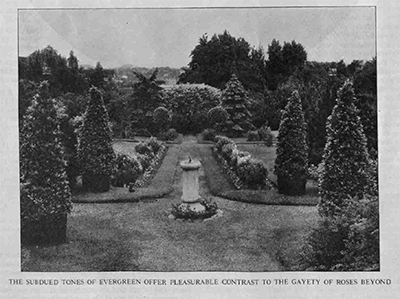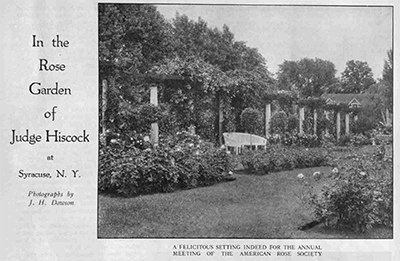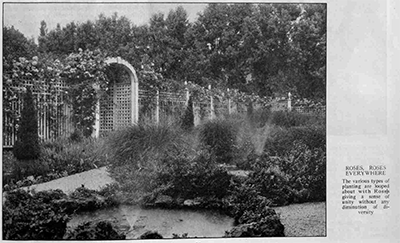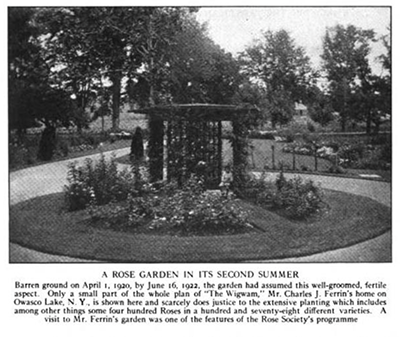|
Because of the notable work done by Rev. Dr. E. M. Mills of Syracuse in organizing a string of Rose societies across the State of New York and because of the interest among amateurs in central New York State, the American Rose Society visited three notable Rose shows on three successive days in Syracuse, Auburn and Rochester. The officers of the Syracuse Rose Society planned and carried out a series of events which resulted in a day which will long remain memorable to the officers of the National Society, members, and visitors who were fortunate enough to enjoy this privilege. June fourteenth began with the judging of the Syracuse show, and except that the number of exhibits was reduced by the ruinous rain storm of the four days preceding, this show reflected a standard mass creditable from the view point of quality as well as quantity, more than 3,500 individual blooms, representative of the popular garden favorites were staged, and it is noteworthy that a determination to have everything correctly named was universal. In this respect the show had a definite educational value. Unfortunately the Rose as a garden flower does not lend itself kindly to indoor exhibition as a cut bloom--it should be seen in the freshness and environment of the growing plant. In this matter the Syracuse people did well, indeed, and arranged for the annual meeting of the visiting national society in the gardens of Judge Hiscock, al fresco! An opportunity was thus afforded to enjoy not alone Roses grown as Roses should be, but also much else in the way of cultural perfection in hardy herbaceous border, in Peonies bordering the walk, in massed shrubbery, lawn, etc. The effective planting of flowering shrubs, evergreens and other things bears tribute to the ability of Mrs. Hiscock to whom the garden is indeed a personal thing. Full advantage is taken of the natural setting of the region and the distant hilltops, brought into the picture as one looks across from the residence, arouse something of the feeling of the classic Greek—better, however, than written word is the photographic record (see pages 28, 29). In Mrs. Hiscock's rose garden each variety is afforded ample opportunity to show itself; each one in a separate bed and twenty plants of each—Willowmere and La Tosca were eminently at home. It was gratifying to learn from the officer's reports that the American Rose Society had completed the most satisfactory year of its existence, financially and otherwise. All the retiring office holders were promptly reëlected: Robert Pyle, West Grove, Pa., President; F. L. Atkins, Rutherford, N. J., Vice-president; John C. Wister, Finance Bldg., Philadelphia, Secretary; Charles H. Totty, Madison, N. J., Treasurer; with James Boyd, Dr. E. M. Mills, and George H. Peterson, as directors. At a subsequent evening public meeting, the visiting national society taking charge of the proceedings, Mr. J. Horace McFarland and others in brief, crisp, chatty manner discussed garden Roses and Rose growing intimately from personal practical viewpoint of the home garden. There was an air of healthy, friendly enthusiasm throughout that was evidence of Rose progress in this particular section of N. Y. state, at all events. The following day the Rose Society of Auburn entertained. This is a veritable nest of Rose growers who support an organization as kindly alert as that of Syracuse. Many local gardens were visited culminating in the garden of David M. Dunning, whose success in growing outdoor Roses has for many years made his home a Mecca for rosarians. A specimen of Frau Karl Druschki in veritable billows of bloom with wrist-sized trunk of ten feet was only one of the outstanding varieties which included among others most prominently, Mrs. Wemyss Quinn, Gloire Chedanne Guinoisseau, Maman Turbat, Lady Pirrie, Gustav Grunerwald, G. Adale Hammond, Avoca, a plant in full bloom six feet high, and Cissie Easlea, one of the richest yellows, though not quite as much a favorite with Mr. Dunning as Daily Mail. Mr. Dunning had a Lion Rose on a trellis 12 feet high a perfect blaze of color. He preferred Willowmere to Los Angeles; and Red Letter Day, while similar in color, was much more vigorous than Kitchener of Khartoum. Mr. Dunning's choice among Hybrid Perpetuals, of which he grows many, were Anne de Diesbach, Baron de Bonstetten, and Ulrich Brunner. An illustration of what may be done in one year was found in Mr. Ferrin's garden. Bare ground in April, 1920, this June it displayed some three hundred Rose plants in full bloom including not only Climbers (the best of which was Paul's Scarlet); Polyanthas (among which Greta Kluis, Marie Pavic, were outstanding sorts, the latter a most inveterate bloomer); but probably most distinguished among the Roses in this new garden were Tree Roses planted only last autumn with heads of generous spread and 12 to 18 blooms per plant, a vindication--if any be needed—of the practicability of fall planting for Roses! Mr. Ferrin explained that it did not require a million dollars or a large property to have Roses. He had started with a swamp and in a short two years had demonstrated the possibility of a Rose garden on a 30 × 100 ft. lot. And then to Rochester, a city that is worthy a visit from any plant lover because of its unique park department. Besides being pleasure grounds, the parks have been systematically developed as gardens and boast collections of shrubs and trees, the equal of any to be found in such educational institutions as, for example, the Arnold Arboretum. To the persistent and sympathetic efforts of Park Superintendent C. C. Laney and his associate, John Dunbar, the gardens of all America owe a debt but little recognized. Here, inspired by the traditions of the nursery enterprises that in past characterized the city, and further stimulated by the just named gentlemen, in a city of gardeners with a plant love and plant knowledge quite remarkable. The Rose exhibition drew an attendance each night of over a thousand—mostly connoisseurs—and the large display by the Park's Department afforded opportunity to renew acquaintance with a couple of score or more true "old-fashioned" varieties of cluster garden Roses which the present recorder had not encountered for a score of years—Hebe’s Lip, Fortune's Copper, Maiden Blush, Pink Monthly, and so on. (See illustration page 41.) Indeed these survivors of olden times quite outclassed in interest the very worthy exhibits of up-to-date varieties of the Hybrid Tea group. All the good things are not necessarily new, and it may be asked whether we have not sometimes unwisely followed the newer gods with too little regard for the old and tried? Which however, is not any disparagement of the new, for where indeed shall we find greater appeal than in the yellow Pernetiana Souv. de Claudius Pernet shown in style that matched its advance claims? L. B. |





